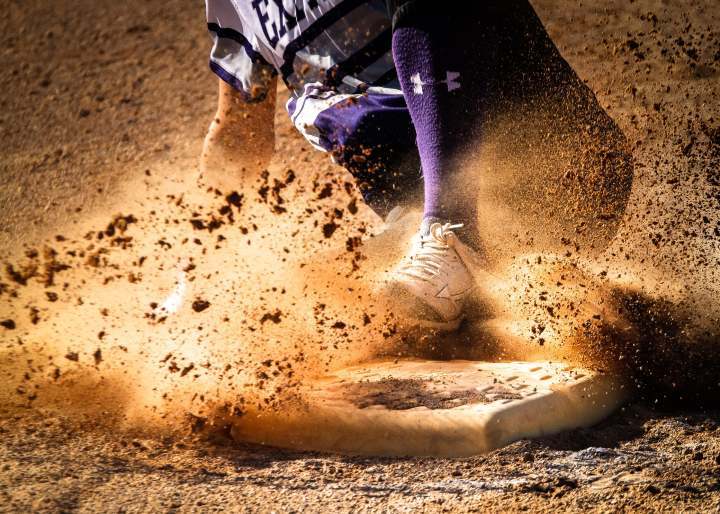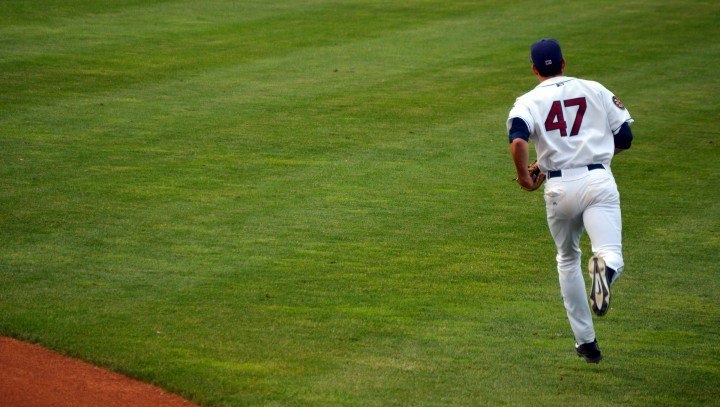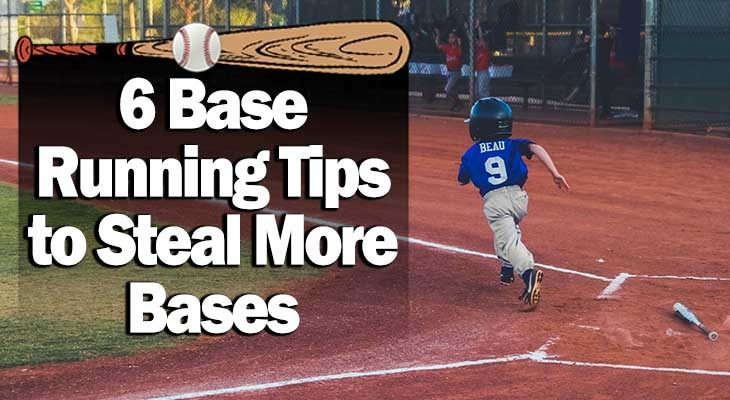Stealing a base is one of the most exciting plays in all of baseball.
It only takes a mere few seconds from the time the base runner breaks for the next base and when the ball arrives at that base from the catcher, which makes the play all the more exciting.
To be a successful at base running, you need to be both quick and fast.
But successfully stealing bases takes more than just pure speed...
Some of the fastest runners aren't good base stealers, because they haven't quite mastered the art of stealing a base.
In essence, stealing a base requires the perfect combination of taking a lead, reading the pitcher's delivery, getting a quick first step, accelerating and running with speed, and finally sliding to avoid any possible tag.
There are plenty of other steps that make up a successful stolen base attempt.
If you want to be able to steal more bases, follow these 6 base running tips.
(For all of these tips, we'll assume you're on first base and trying to steal second base.)

Six Base Running Tips
1. Take the Proper Lead
Leading off the bag is something every runner does before every pitch. It involves you taking a few lateral steps off the bag you're at toward the bag that's next.
Most runners will either shift their weight back toward the bag or try to keep it centered, so as to give them the best chance possible to get back to the bag on pick-off attempts by the pitcher.
The first step to establishing a proper lead is to take it off the back corner of the base. This will allow you to avoid a tag on a pickoff attempt as well.
Visualize a straight line between you and second base, because that's the path you're going to take.
If you're a taller person, you can take a bigger lead.
If you're shorter, take a smaller lead.
You want to be at least three strides off first base when you're attempting to steal, to give yourself a nice head start.
2. Position Your Feet Properly
The typical runner will position his feet square back toward the third-base line.
But if you want to steal bases successfully, a great way to do so is to position the tips of your feet in the direction you're going to run.
If there were a clock in front of you on the ground when you take your lead, you want to imagine your left foot at 1:00 and your right foot at 2:00.
3. Watch the Pitcher
One of the most important aspects of base stealing is getting a good jump.
The goal is to start running toward second base as early as possible, but not so early that the pitcher recognizes it and picks you off.
This step in the base running tips, then, is all about timing and reading the pitcher.
Watch the pitcher closely.
If you have film on him or her, or at least can watch him when he's in the stretch earlier in the game, that would be great.
This may help you know what the pitcher does with his head, how many times he looks toward runners at first, etc., before throwing the pitch.
When the pitcher is taking signs from the catcher, start your initial lead, which will be a step or two off the bag.
When he comes set after taking the signs, take your secondary lead, which will be another stride or two toward second base.
The next goal is to start running toward second base the moment he makes the first move to lift his foot off the rubber.
This will give you the longest amount of time between when he starts his stride and when the catcher could be able to receive the ball and throw it to second to try to catch you stealing.
There are certain things that you can pay attention to that just about every pitcher will do that will perhaps tip you off to when he is going to throw home and when he is going to attempt a pickoff.
If the pitcher is right-handed, watch his left heel.
If it comes off the ground while his right heel remains on the rubber, then you know he's going to throw to home plate. If, however, his feet shift quickly and his right heel comes off the ground, too, then he's most likely going to attempt a pickoff to first base.
Another thing to look out for is the back knee of the pitcher.
If it bends when he starts his motion, then he's going to throw to home plate. This is because he'll need to do this to get enough momentum behind the pitch. If the knee stays straight when he starts to move, though, he's most likely going to spin and try to pick you off first base.
4. Perfect Your First Move
We just talked about paying attention to the pitcher's first move, but your first move toward second base is extremely important in determining whether your base stealing attempt will be successful.
The biggest mistake runners make when trying to steal a base is they drop their right foot into position first and then leap forward toward second base with their left foot.
In reality, the best way to steal a base is to make your first move with your left foot. You'll be able to reach second base much faster if you make your first move with your left foot in a leaping motion.
Doing this will also allow you to stay on a straight path toward second base inside the baseline better than if you planted your right foot into position first.

5. Sprint Toward Second Base
After you make that first leap with your left foot, you'll be turning your body from being square to the third-base line to now running directly toward second base.
Your head will face completely toward second base now.
Now, it's time to sprint and run as fast as you can toward second base.
Your head should be down and you should motor as fast as you can.
If you're attempting a straight steel, you want to try to avoid looking back toward home plate if you can.
There will definitely be an urge for you to do so, so that you can see what situation you're in. However, doing this will slow you down.
To know how the play is progressing, listen to your coaches for direction, as well as other familiar sounds -- such as the pop of the catcher's mitt or the crack of the bat.
Your first and third base coach should be yelling out to you to slide or if you can just go into second base standing up.
If you hear the catcher's mitt pop, you know that he has received the pitch and that a throw down to second base is likely to follow.
If you hear a crack of the bat, then you should look back to see what happens.
If the ball is hit in the air, for example, you need to retreat to first base so you're not doubled off.
If the ball looks like it's going to land safely in the outfield, then you want to make your turn around second base so that you can head to third base -- or even home plate.
6. Time Your Slide Perfectly
The final tip to steal more bases is to time your slide perfectly.
Sliding into second base will be an important way that you can get to second base in the quickest fashion.
One thing that you should keep in mind is that the quickest way to the base is to run in a straight line and sliding straight into the bag.
The only reason why you may want to not slide straight into the bag -- such as a hook slide -- is if you want to avoid a tag.
Also, the safest way to slide into a bag is feet first. That way, you don't risk getting hit in the head with the ball, the tag, or jamming one of your arms/fingers.
You should start your slide when you are about three to five feet away from the base. This will give you time to tuck your leg under your body and slide into the bag without, again, jamming any of your body parts onto the bag too hard.
The key here is to make sure that you start your slide at this five-foot mark.
If you start to slide too early, you risk stopping short of the base and being tagged out too early. Even if you do reach the bag, it'll take you much longer to do so if you start too soon.
If you start your slide too late, you run the risk of getting hurt -- as we mentioned before -- and also of making yourself too big of a target for the shortstop or second baseman to tag out.
Again, try to take a direct path to the bag when you are running, and continue your slide in that direct path as well.
If, however, you see that the person manning the bag has received the ball right as you're about to start your slide, you can employ a hook slide to try to avoid the tag.
What you'll do in this instance is actually slide with your feet to the front of the bag (less likely) or the back of the bag (more likely), and grab the base with your hand.
If you're able to recognize that the player manning the base is going to place the tag right in your running path, then simply adjust the angle at which you're going to slide. You want to aim your feet about a foot or two to the back side of the bag, toward right-center field.
Then, as you are just about to slide past the bag, you want to reach out with your left arm and grab the back corner of the bag. This will help you "hook" your body around the bag, which gives the type of slide its name.
You don't want to slide too far away, otherwise you won't be able to reach the bag with your hand. At the same time, you don't want to slide too close, otherwise you won't be avoiding the tag at all.
Conclusion
A base stealing attempt is one of the most exciting plays in all of baseball.
It's a very quick "bang-bang" play, but there's a lot of action that happens in a short amount of time.
But base running isn't all about running as fast as you can.
There are a few tips and tricks to improving your ability to steal a base, and if you follow the 6 tips above, you'll be well on your way to stealing more bases.

